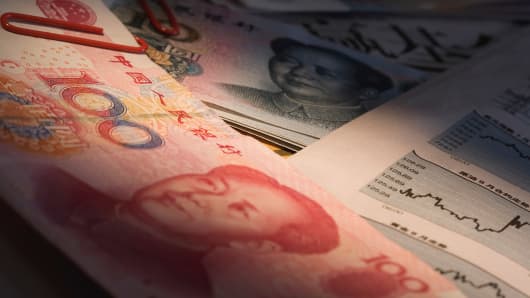Chinese outbound foreign direct investment (ODFI) was the largest on record in December, demonstrating Chinese companies' increasing appetite for foreign assets and a balancing out of the country's cross-border capital flows.
Having been the world's largest recipient of foreign direct investment over the last decade, China has begun to return the favor.
Chinese non-financial ODFI totaled $14.7 billion in December and $24.7 billion in the fourth quarter, Ministry of Commerce data released on Wednesday showed. That is up from $17.1 billion in the third quarter and $15.5 billion in the fourth quarter of 2011.
(Read More: Soft Power: China's Wanda Eyes US Hotel, Movie Deals)
The most recent monthly and quarterly totals are the highest since MOFCOM began publishing quarterly data in 2009 and monthly data in 2010.
December was also the first month on record in which outbound FDI exceeded inbound FDI. Non-financial inbound FDI was $11.7 billion in December, down from $12.2 billion in December 2011.
For full-year 2012, OFDI was $77.2 billion, up from $60.1 billion in 2011 and only $12 billion in 2005. Inbound FDI was $111.7 billion, down from 2011's record high of $116.0.
Analysts say rising labor costs and slowing growth have decreased China's attractiveness as a destination for FDI. Countries like Vietnam and India are now the preferred markets for many investors to establish low-wage manufacturing bases.
At the same time, authorities have supported Chinese companies to invest abroad as part of their decade-old "go out" policy designed to develop national champion firms that can compete with Western multi-nationals.
(Slideshow: Top 10 Countries for Chinese Investments)
There was no breakdown given for the destination of Chinese overseas investment, though previous analyses have concluded that China's overseas investment is spread fairly evenly around the globe. MOFCOM's spokesman said on Thursday that investment to Russia, the United States, and Japan had grown the fastest in 2012.
Big Deals
Monthly FDI and OFDI data is typically volatile, and it was unclear what accounted for the big jump in December. It is also common for MOFCOM to record deals for their statistics weeks or months after the deal is announced.
Chinese state oil major CNOOC's $17.7 billion purchase of Canadian oil and gas producer Nexen was the largest deal signed this year, according to the Thomson One deals database, but the acquisition is still pending approval by U.S. regulators .
The second-biggest deal in 2012, also announced in December, was the purchase by a consortium of Chinese investors led by New China Trust Co Ltd of International Lease Finance Corp from American International Group.
Part of the surge in OFDI was also likely to have reflected efforts by firms or wealthy individuals to evade China's capital controls.
China's closed capital account mean that Chinese residents are restricted from transferring money overseas if they want to buy financial assets, property, or make direct corporate investments not approved by MOFCOM.
A Reuters analysis showed that hot money outflows accelerated in the second half of 2012.


